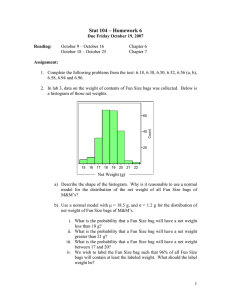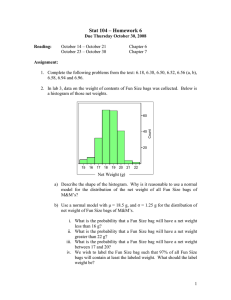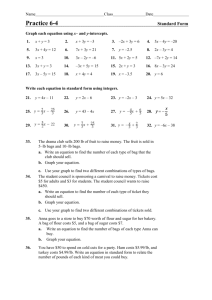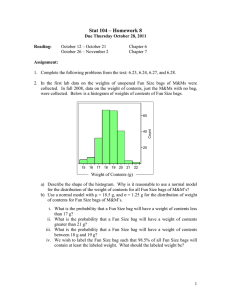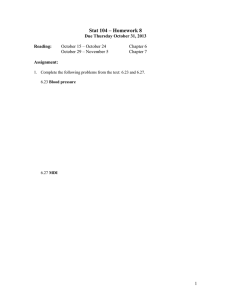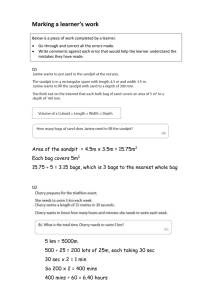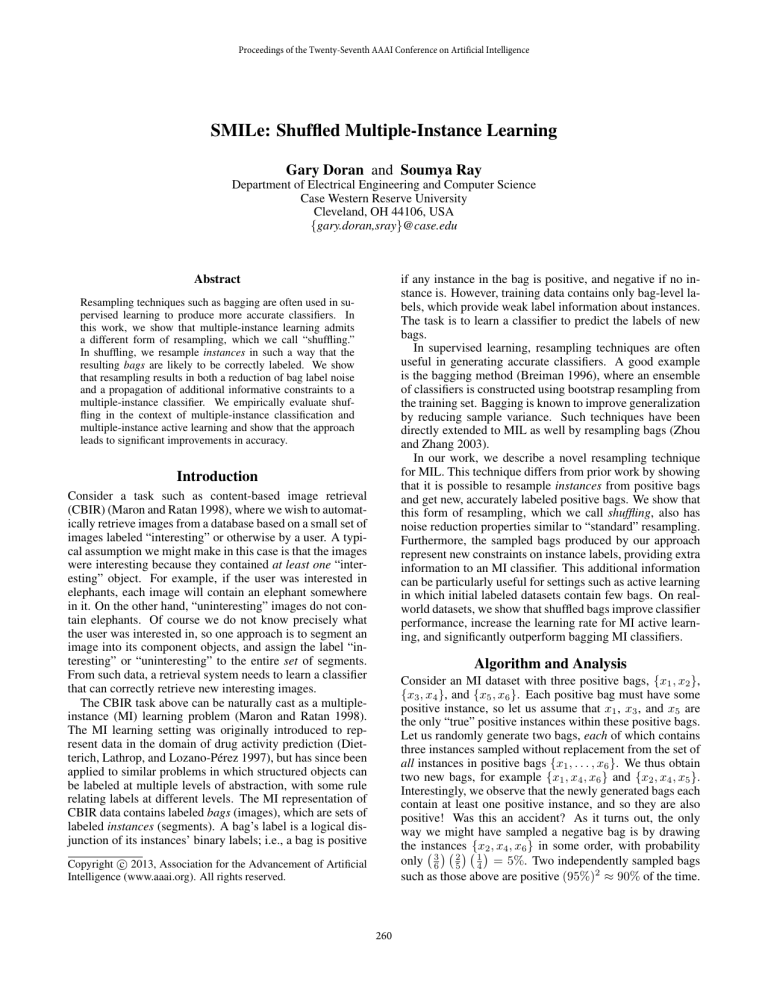
Proceedings of the Twenty-Seventh AAAI Conference on Artificial Intelligence
SMILe: Shuffled Multiple-Instance Learning
Gary Doran and Soumya Ray
Department of Electrical Engineering and Computer Science
Case Western Reserve University
Cleveland, OH 44106, USA
{gary.doran,sray}@case.edu
Abstract
if any instance in the bag is positive, and negative if no instance is. However, training data contains only bag-level labels, which provide weak label information about instances.
The task is to learn a classifier to predict the labels of new
bags.
In supervised learning, resampling techniques are often
useful in generating accurate classifiers. A good example
is the bagging method (Breiman 1996), where an ensemble
of classifiers is constructed using bootstrap resampling from
the training set. Bagging is known to improve generalization
by reducing sample variance. Such techniques have been
directly extended to MIL as well by resampling bags (Zhou
and Zhang 2003).
In our work, we describe a novel resampling technique
for MIL. This technique differs from prior work by showing
that it is possible to resample instances from positive bags
and get new, accurately labeled positive bags. We show that
this form of resampling, which we call shuffling, also has
noise reduction properties similar to “standard” resampling.
Furthermore, the sampled bags produced by our approach
represent new constraints on instance labels, providing extra
information to an MI classifier. This additional information
can be particularly useful for settings such as active learning
in which initial labeled datasets contain few bags. On realworld datasets, we show that shuffled bags improve classifier
performance, increase the learning rate for MI active learning, and significantly outperform bagging MI classifiers.
Resampling techniques such as bagging are often used in supervised learning to produce more accurate classifiers. In
this work, we show that multiple-instance learning admits
a different form of resampling, which we call “shuffling.”
In shuffling, we resample instances in such a way that the
resulting bags are likely to be correctly labeled. We show
that resampling results in both a reduction of bag label noise
and a propagation of additional informative constraints to a
multiple-instance classifier. We empirically evaluate shuffling in the context of multiple-instance classification and
multiple-instance active learning and show that the approach
leads to significant improvements in accuracy.
Introduction
Consider a task such as content-based image retrieval
(CBIR) (Maron and Ratan 1998), where we wish to automatically retrieve images from a database based on a small set of
images labeled “interesting” or otherwise by a user. A typical assumption we might make in this case is that the images
were interesting because they contained at least one “interesting” object. For example, if the user was interested in
elephants, each image will contain an elephant somewhere
in it. On the other hand, “uninteresting” images do not contain elephants. Of course we do not know precisely what
the user was interested in, so one approach is to segment an
image into its component objects, and assign the label “interesting” or “uninteresting” to the entire set of segments.
From such data, a retrieval system needs to learn a classifier
that can correctly retrieve new interesting images.
The CBIR task above can be naturally cast as a multipleinstance (MI) learning problem (Maron and Ratan 1998).
The MI learning setting was originally introduced to represent data in the domain of drug activity prediction (Dietterich, Lathrop, and Lozano-Pérez 1997), but has since been
applied to similar problems in which structured objects can
be labeled at multiple levels of abstraction, with some rule
relating labels at different levels. The MI representation of
CBIR data contains labeled bags (images), which are sets of
labeled instances (segments). A bag’s label is a logical disjunction of its instances’ binary labels; i.e., a bag is positive
Algorithm and Analysis
Consider an MI dataset with three positive bags, {x1 , x2 },
{x3 , x4 }, and {x5 , x6 }. Each positive bag must have some
positive instance, so let us assume that x1 , x3 , and x5 are
the only “true” positive instances within these positive bags.
Let us randomly generate two bags, each of which contains
three instances sampled without replacement from the set of
all instances in positive bags {x1 , . . . , x6 }. We thus obtain
two new bags, for example {x1 , x4 , x6 } and {x2 , x4 , x5 }.
Interestingly, we observe that the newly generated bags each
contain at least one positive instance, and so they are also
positive! Was this an accident? As it turns out, the only
way we might have sampled a negative bag is by drawing
the instances
{x2 , x4 , x6 } in some order, with probability
only 63 25 14 = 5%. Two independently sampled bags
such as those above are positive (95%)2 ≈ 90% of the time.
Copyright c 2013, Association for the Advancement of Artificial
Intelligence (www.aaai.org). All rights reserved.
260
Therefore, if we pool together all instances from positive
bags, and sample without replacement enough times to create new bags, then the generated bags will be (with high
probability) positive as well. Note that we did not need to
know or estimate the individual instance labels during the
resampling process.
This seems to be an interesting fact, but what is the value
added by these new bags? Let f be the function that assigns
“true” or “false” labels to these instances, corresponding to
positive and negative. Each positive bag is then labeled by
a disjunction over instance labels, and serves as a constraint
on f : we are looking for an f that satisfies all constraints.
Viewing things from this angle, we notice that the new bags
can add new constraints: in the above example, we knew
that one of x1 or x2 must be positive; after we add the new
bags, we know that one of x1 , x4 or x6 must be positive
as well. If the classifier is reasonably confident that x4 and
x6 are negative, this added constraint makes x1 much more
likely to be positive. In general, we can view these added
bags as constraints that are (probabilistically) deduced from
the initial set. While a rule-based MI algorithm might be
able to infer such constraints from the given data, we conjecture (and demonstrate empirically) that certain statistical
learning algorithms benefit greatly by having these made explicit, especially when the initial training set is small.
A second value addition that we demonstrate below is
that, because we control the parameters of the resampling
process, it is able to reduce bag-level label noise in the original data, which improves generalization and reduces overfitting. This benefit is similar to standard bootstrap resampling. As we demonstrate in the experiments, the combination of these two effects leads to very effective improvements in performance, especially when few labeled bags are
available.
We note that, like other resampling procedures such as
bagging, this approach “wraps around” any base classifier.
However, unlike bagging, this is not inherently an ensemble
method. It is perfectly feasible in our setting to simply add
the new bags as constraints to the data, and run the base MI
algorithm on the expanded sample. This is how we apply
the technique in our experiments. In some respects, this is
an advantage; for example, we do not need to worry about
the additional storage costs of an ensemble, and the interpretability of the base classifier is not affected. We call our
approach Shuffled Multiple-Instance Learning (SMILe).
We illustrate SMILe concretely with an example from
the CBIR domain. Suppose we have two positive images
from the “Coke Can” class, shown in Figure 1. In the MI
representation, images are structureless “bags” of segments.
Therefore, we can pool segments together and sample without replacement to generate synthetic images, such as those
shown in the bottom of Figure 1. By sampling enough segments, the synthetic images are also likely to be positive, as
they visibly are in this example.
To formalize SMILe, we define some notation. Suppose we have an MI dataset given by a list of bags B
and associated labels Y , with Bi = {xij ∈ Rn } and
Yi ∈ {−1, +1}. The set of positive bags is denoted by
Bp = {Bi | Yi = +1}, and the set of positive bag instances
Figure 1: Top: Two positive images from the “Coke Can”
class. Bottom: Two bags generated by sampling instances
from the two images above.
S
by Xp = Bp . The positive bag instances Xp are not the
same as the set of positive instances, since some instances
in positive bags might be negative. We can generate a set
S of additional positive bags, each containing s instances
sampled without replacement from the set of positive bag instances Xp (with replacement between each sampled bag).
The set B ∪ S is then given to any MI classification algorithm A, and the resulting classifier is used to predict new
bag labels.
We first show that the process we have outlined can always generate positive bags with high probability. In the
worst case, only one positive instance in each of the positive
bags Bp will be positive, for a total of |Bp | true positive instances. The remaining |Xp | − |Bp | positive bag instances
will be negative. Therefore, the probability of generating a
bag with all negative instances is at most the chance of sams
pling a negative instance s times, or ((|Xp | − |Bp |) / |Xp |) .
In fact, this bound could be improved, since sampling without replacement makes each additional negative instance
less likely to be drawn. Nonetheless, we see that the probability of sampling a negative bag, which translates to label
noise in S, decreases exponentially with shuffled bag sizes
s. Therefore, we can generate positive bags with high probability by adjusting s appropriately:
Proposition 1. Suppose a set of shuffled bags is generated
from an MI dataset without label noise on the original bags.
Then if each shuffled bag is of size s ≥ C1 log 1s , where
C = log |Xp | − log (|Xp | − |Bp |), 1 − s of the resulting
bags will be positive.
261
Proof. To bound the true label noise on S, it is sufficient to
s
bound ((|Xp | − |Bp |) / |Xp |) by the desired noise level, s .
Thus, we have:
to approximate the behavior of an instance-based MI classifier. First, the algorithm arbitrarily assigns labels to instances within bags such that their labels respect the MI condition. That is, all instances in negative bags are labeled
negative, and at least one instance in each positive bag is labeled positive. Then, a supervised classifier is trained on the
resulting instance-labeled dataset. This is similar to the behavior of algorithms such as mi-SVM (Andrews, Tsochantaridis, and Hofmann 2003), which perform these two steps
simultaneously.
Now, assume that instances are separable, and the supervised learning step above returns a consistent classifier.
Therefore, all instances in negative bags are labeled correctly by the classifier. However, consider the following
types of instances from Xp , the instances in positive bags:
(i) the set of instances P selected to be labeled positive by
the classifier, (ii) the set of instances in Xp − P that are labeled negative, but whose true labels are positive, and (iii)
the set of instances in Xp − P that are correctly labeled negative (from the set the negative instances in positive bags).
Let δ− be the false negative rate in positive bags, i.e. the
fraction of the instances in Xp − P in category (ii).
Suppose now that we add a single shuffled bag to our
dataset and observe the marginal change in the classifier.
There are two major cases: (1) some instance in the shuffled bag is in P , or (2) all instances in the shuffled bag are in
Xp − P . In the first case, the added shuffled bag is already
consistent with the classifier (it is a positive bag containing
at least one positively labeled instance), so it does not induce a change in the current classifier. The second case has
two sub-cases: (2a) the shuffled bag contains at least one
true positive instance from category (ii) above, or (2b) the
shuffled bag only contains negative instances from category
(iii) above. In case (2a), we expect the added bag to improve
the classifier, since it adds useful, correct constraint information that requires a change in the current classifier. On
the other hand, case (2b) is the introduction of a noisy bag,
which would also induce a change in the classifier, but based
on incorrect information. However the chance of this happening is bounded by the propositions above and the number
of shuffled bags already introduced, as we discuss below.
How many shuffled bags should be used? For a shuffled
bag to have a marginal effect, it must fall under case (2), so
each of its s instances must be drawn from Xp − P , which
s
occurs with probability at least ((|Xp | − |P |) / |Xp |) .
Given that a shuffled bag falls under case (2), the probability
that it is harmful as in (2b) is (1 − δ− )s , since every instance
must be drawn from category (iii) of the instances in Xp .
Therefore, as more shuffled bags are added, those of type (2)
that have an effect on the classifier will cause more instances
to be added to P to satisfy constraints. This decreases the
probability that subsequent sampled bags will be of type (2).
Furthermore, as bags of type (2a) are sampled, the classifier
will use the added constraints to reduce the false negative
rate δ− on positive bag instances. This makes it less likely
that subsequent shuffled bags will be of type (2a) and more
likely they will be (2b). The exact quantitative nature of the
tradeoff between the extra information contained in the constraints of additional shuffled bags and the detrimental ef-
s
s ≥ ((|Xp | − |Bp |) / |Xp |)
log s ≥ s [log (|Xp | − |Bp |) − log |Xp |]
log
1
s
≤ s [log |Xp | − log (|Xp | − |Bp |)]
s≥
log
1
s
log |Xp | − log (|Xp | − |Bp |)
.
Thus, even in the worst case when there is only one positive instance per positive bag, we can achieve low noise s in
bags with only O(log 1s ) instances. As an example, for the
CBIR datasets described in our experiments, positive bags
contain approximately 30 instances. For a worst-case noise
level of 10%, this requires sampling roughly 70 instances
per shuffled bag. Of course, the process of sampling without
replacement cannot continue indefinitely, and if s exceeds
|Xp | − |Bp |, then the resulting sampled bag is guaranteed to
be positive, since all instances from some positive bag will
have been sampled.
We next turn to the question of the value added by the
new bags. First, the analysis above suggests that SMILe can
reduce existing positive bag label noise in an MI dataset:
Proposition 2. Suppose an MI dataset B contains bags with
label error > 0. By choosing s sufficiently small, the noise
on the resulting dataset B ∪ S will be b
< , where S is the
set of shuffled bags added to the dataset.
Proof. Suppose bag label error is decomposed such that
+ > 0 of positively labeled bags in an MI dataset are negative, and − > 0 of the negatively labeled bags are positive.
Now, the worst case number of positive instances in positive
bags is reduced from |Bp | to (1 − + ) |Bp |. For an abitrary
desired s error rate on the labels of shuffled bags, we choose
s, the size of a shuffled bag, to satisfy:
s
s ≥ ((|Xp | − (1 − + ) |Bp |) / |Xp |) ,
then as in the proof above, we must pick shuffled
bags of size s ≥ C1 log 1s , where C = log |Xp | −
log (|Xp | − (1 − + ) |Bp |). The resulting dataset with shuffled bags labeled positive has |Bn | bags with noise − , |Bp |
bags with noise + , and |S| bags with noise s , for a total
noise rate of:
− |Bn | + + |Bp | + s |S|
b
=
.
|B| + |S|
If we choose s small enough so that s < min{− , + }, this
is sufficient to have b
< when shuffled bags are added.
This shows that like other resampling methods such as
bagging, SMILe can reduce variance by reducing noise in
an MI dataset.
We next discuss a second benefit of shuffling: its potential to improve performance by introducing additional constraints on an MI classifier. Because the nature of the constraints added by SMILe depends on the particular MI classifier used, we sketch a “template” algorithm below intended
262
feltflowerrug
0.84
AUC
0.82
0.80
0.78
0.76
0
0.66
20
30
40
50
0.66
0.60
0.64
0.58
0.62
0
10
20
30
Queries
40
50
0.60
juliespot
0.74
0.72
0.70
0.68
0.66
0.64
0
10
20
30
40
50
0.62
0
0.70
cardboardbox
0.68
0.62
0.56
stripednotebook
0.70
smileyfacedoll
0.64
AUC
10
0.82
0.80
0.78
0.76
0.74
0.72
0.70
10
20
30
40
50
rapbook
0.65
0.60
Shuffled Bags
0.55
0
0
10
20
30
Queries
40
50
0.50
0
10
10
20
30
Queries
20
40
50
Figure 2: (MI Active Learning) Learning curves for the active learning experiments on selected SIVAL datasets showing a
variety of behaviors. Each plot shows results using 0, 10, or 20 shuffled bags, starting with 20 initial bags of each class.
The NSK maps entire bags into a feature space, and can be
used with a standard SVM QP formulation. The approach
works well in practice and is efficient since the bottleneck
optimization step is on the order of the number of bags rather
than the number of instances.
The NSK uses bag-level information for classification,
mapping positive and negative bags into a feature space irrespective of the specific MI assumption of at least one positive instance per positive bag. Thus, shuffled negative bags
are also used in the experiments since they might provide additional information to the bag-level classifier. Since all negative bag instances are negative, the resulting shuffled bags
are also guaranteed to be negative, and no noise is added.
In our experiments, a linear instance kernel kI is used to
construct the NSK (see Equation 1) since more powerful
kernels tend to overfit small datasets. The SVM regularization trade-off parameter is fixed at 1.0. All experiments
are implemented in Python using the scikit-learn library (Pedregosa et al. 2011).
We hypothesize that the addition of shuffled positive bags
(and new instance constraints) is particularly useful for the
active learning setting, in which users are iteratively queried
for labels in a manner that maximizes classifier accuracy
while minimizing labeling effort (Cohn, Ghahramani, and
Jordan 1996). Because active learning labels are acquired
by querying a human user (at some expense), initial training
sets contain very few labeled examples.
fects of introducing incorrectly-labeled shuffled bags to the
dataset depends on the particular MI classifier used. Therefore, experimental evaluation and cross-validation should be
used to determine an optimal number of shuffled bags.
The discussion above indicates that shuffling will be most
beneficial when the false negative rate δ− is initially high
without shuffled bags, and that shuffling will not always
add additional constraint information. For example, if δ− is
initially low, then bags corresponding to “new” constraints
are likely to be incorrectly labeled. However, even though
the constraint-propagation aspect of SMILe will not always
work, noise reduction as in Proposition 2 might still be possible. We next show that in practice, SMILe is effective in
significantly improving accuracy for MI classification and
MI active learning.
Empirical Evaluation
We hypothesize that using SMILe to add shuffled bags to
an MI dataset will increase the performance of an MI classifier trained on the augmented dataset. Numerous supervised learning approaches, such as decision trees (Blockeel,
Page, and Srinivasan 2005), artificial neural networks (Ramon and Raedt 2000; Zhou and Zhang 2002), Gaussian
models (Maron 1998; Zhang and Goldman 2001), logistic
regression (Xu and Frank 2004; Ray and Craven 2005), and
kernel methods such as support vector machines (SVMs)
(Gärtner et al. 2002; Andrews, Tsochantaridis, and Hofmann
2003) have been extended to the MI setting. In this work,
we use SVM classifiers for our empirical analysis. Many
MI SVM approaches modify the constraints of the standard
SVM quadratic program (QP) to take into account the MI
relationship between instance and bag labels. Another MI
SVM approach, which we use in our empirical analysis, is
the normalized set kernel (NSK) (Gärtner et al. 2002). The
NSK uses an average of pairwise instance kernel values to
compute a kernel between two bags:
X X
1
kI (x, x0 ).
kNSK (Bi , Bj ) =
(1)
|Bi | |Bj |
0
Multiple-Instance Active Learning
Active learning in the MI setting was explored in prior work
(Settles, Craven, and Ray 2008), where instance labels are
queried to improve an instance classifier initially trained
with few labeled bags. In these experiments, we instead focus on the bag classification task in which a user is queried
for the labels of bags to train a classifier for predicting the
labels of bags in a test dataset. Previous work has specifically established the use of the NSK with MI active learning
for image classification (Liu et al. 2009).
In our active learning experiments, we use the 25
x∈Bi x ∈Bj
263
Fraction Improved
1.0
1.0
5 Initial Bags
0.9
1.0
10 Initial Bags
0.9
0.8
0.8
0.8
0.7
0.7
0.7
0.6
0.6
0.6
0.5
0.5
0.5
0.4
0
5
10
15
Queries
20
25
0.4
0
5
10
15
Queries
20
20 Initial Bags
0.9
25
0.4
Shuffled Bags
10
0
20
5
10
Significant
15
Queries
20
25
Figure 3: (MI Active Learning) Each plot shows an active learning experiment starting with 5, 10, or 20 initial bags. For
both 10 and 20 shuffled bags, the y-axis plots the fraction of times (across the 25 datasets) SMILe outperforms the baseline of
no shuffled bags as the number of bag label queries increases along the x-axis. Stars indicate a significant difference between
SMILe and baseline AUC values using a 2-sided Wilcoxon signed-rank test at 0.05 significance.
AUC
elephant
fox
tiger
0.85
0.64
0.85
0.80
0.62
0.80
0.75
0.60
0.75
0.70
0.58
0.70
0.65
0.56
0.65
Bagging
Shuffled Bag Label Noise
10%
0.60
0
200
400
600
800 1000 1200 1400
Shuffled Bags / Iterations
0.54
0
200
400
600
800 1000 1200 1400
Shuffled Bags / Iterations
0.60
0
200
400
30%
600
50%
800 1000 1200 1400
Shuffled Bags / Iterations
Figure 4: (MI Classification) Results of adding shuffled bags to MI classification datasets with shuffled bag sizes corresponding
to various noise levels. The performance of bagging is also shown for comparison. The x-axis indicates either the number of
shuffled bags for SMILe, or the number of bagging iterations used. Using a permutation test with a 0.001 significance level,
the advantage of SMILe over the baseline (no shuffled bags) becomes significant after the addition of 50 shuffled bags for
elephant and tiger, and 200 shuffled bags for fox. Similarly, SMILe significantly outperforms bagging on all three
datasets.
which is much smaller at 0.002%. The discrepancy between
worst-case and actual noise occurs because there are frequently several positive instances per positive bag, whereas
Proposition 1 assumes that there is only one positive instance per positive bag. Thus, in practice SMILe adds almost zero noise to the training set.
instance-annotated Spatially Independent, Variable Area,
and Lighting (SIVAL) datasets from prior work (Settles,
Craven, and Ray 2008), but unlike that work, we only use
bag-level labels during the training process. Results are averaged over 10 repetitions. Within each repetition, 5 folds
are used to compute a pooled area under receiver operating
characteristic (ROC) curve (AUC), which is averaged across
repetitions. Within the training set corresponding to each
fold, either 5, 10, or 20 initial bags of each class are randomly selected and labeled, and either 10 or 20 shuffled bags
of each class are added to the initial dataset. The remaining
training set bags are placed in a pool. Then, at each iteration of the active learning process, the label of an unlabeled
bag is queried from the pool. We use the “simple margin”
strategy (Tong and Koller 2002) for querying bag labels by
choosing the bag closest to the SVM separator in the NSK
feature space. After each query, the classifier is retrained
and evaluated on a test set.
Figure 2 shows example learning curves for several SIVAL datasets. A plot for each dataset shows
the AUC of classifiers trained with 20 initial bags,
and either 0, 10, or 20 shuffled bags augmenting the
initial dataset.
These datasets illustrate cases when
SMILe does (feltflowerrug, stripednotebook,
smileyfacedoll, cardboardbox) and does not
(juliespot, rapbook) improve performance.
Looking at the curves for feltflowerrug and
stripednotebook, we see how shuffling appears to prevent overfitting. Without shuffled bags, overfitting seems to
occur after approximately 15–25 bag label queries. However, with the addition of shuffled bags, classifier performance is maintained or improved even after 25 queries. For
the smileyfacedoll dataset, shuffling seems to be especially useful during the first 20 queries when the training
set is small. Finally, SMILe appears to accelerate the learn-
Shuffled bag size is determined using the formula in
Proposition 1, with s = 0.1 for a worst-case label noise
level of 10% on the shuffled bags. Because instances in
these SIVAL datasets are labeled (but these labels are not
used during training), we can compute the actual noise level,
264
nificant after 50 bags are added to elephant and tiger
datasets, and after 200 bags are added to the fox dataset.
As we discuss in the analysis above, although SMILe
is a resampling technique similar to bagging, we hypothesize that by resampling instances rather than bags, SMILe
can provide an additional information about instance constraints. To demonstrate this effect, the MI bagging algorithm described in prior work (Zhou and Zhang 2003) is implemented and used to produce the results in Figure 4. These
results show the advantage of SMILe over bagging and are
also significant with p = 0.001 using ensembles of up to
1500 classifiers trained on bootstrap replicates.
ing rate for the cardboardbox dataset so that shuffling
improves performance across all 50 queries.
For the juliespot dataset, SMILe decreases performance by a nearly constant amount, perhaps because shuffled bags introduce more noise than useful constraint information in this case. The performance on the rapbook
dataset begins similarly across various numbers of shuffled
bags, but does not improve as quickly when shuffling is
used. Although classifier performance is occasionally hindered by shuffled bags, there are many more cases in which
it is improved.
Figure 3 summarizes the results of active learning curves
across all 25 datasets, showing the relative performance of
SMILe with various numbers of shuffled bags to the baseline
algorithm that does not use shuffling. The plots show, for
various numbers of initial labeled bags, the fraction of the
25 datasets for which SMILe outperforms the baseline as up
to 25 bags are queried via the active learning process. A
2-sided Wilcoxon signed-rank test with a 0.05 significance
level is used to compare paired AUC values across datasets
for SMILe and the baseline at each point along the curve.
Significant results are indicated with stars.
From Figure 3, we see that the addition of shuffled bags
increases classifier performance, especially during the first
10–20 queries. With more than 5 initial bags, the performance of classifiers using various numbers of shuffled bags
seem indistinguishable after approximately 25 queries. This
is expected since in these experiments, additional shuffled
bags are not generated as new labeled bags are added to the
training set. If shuffled bags were continually added to the
training set with each query returning a positive bag, performance would likely continue to improve above the baseline.
Related Work
In the standard supervised learning setting, resampling and
ensemble approaches such as bagging (Breiman 1996) and
boosting (Freund and Schapire 1996) can improve classifier
performance, for example by reducing the variance of algorithms that are unstable given small changes in the training
set. Prior work investigates extending bagging to the MI setting by resampling entire bags to create bootstrap replicas of
B (Zhou and Zhang 2003). Similarly, boosting is extended
to the MI setting by iteratively training a weak classifier on
a set of weighted bags (Auer and Ortner 2004). SMILe differs from previous approaches by resampling at the instance
level rather than at the bag level. Furthermore, unlike previous MI resampling techniques, SMILe is not formulated as
an ensemble method, but uses resampling to construct a single augmented dataset used to train any MI classifier. Future
work will explore an instance resampling technique like in
SMILe combined with an ensemble approach like bagging.
In the CBIR domain, some image classification tasks require stronger assumptions relating instance and bag labels
(Zhou, Sun, and Li 2009). For example, the Coke cans in
Figure 1 are segmented such that several positive instances
are required before an image properly contains an entire
Coke can. However, our analysis uses the standard MI setting assuming that it is sufficient for an image of an object
to contain at least one part of that object.
Multiple-Instance Classification
In this set of experiments, we test the hypothesis that
the addition of shuffled bags improves classifier performance in the standard MI setting using the CBIR datasets
elephant, fox, and tiger (Andrews, Tsochantaridis,
and Hofmann 2003). As in the active learning experiments,
results are averaged over 10 repetitions. For these datasets,
10 folds are used to compute pooled AUC. Within each fold,
between 0 and 1500 additional positive and negative shuffled bags are added to the training set. The worst-case noise
level of shuffled bag labels varied from 10% to 50% with the
formula in Proposition 1 used to derive the appropriate shuffled bag size. We expect that the true label noise on shuffled
bags is smaller due to multiple positive instances per positive bag, but that the utility of shuffled bags decreases as the
label noise is increased.
The plots in Figure 4 show the results of shuffling for MI
classification. For each dataset, the addition of shuffled bags
clearly improves classifier performance, even after several
hundred shuffled bags have been added. Furthermore, the
performance improves even with a theoretical worst-case
noise level of 50%. This seems to suggest that there are
in fact multiple positive instances per positive bag, so the
noise level is actually much lower than worst-case estimates.
A permutation test to compare ROC curves of individual
classifiers shows that improved performance becomes sig-
Conclusion
We have presented a new resampling technique for MI learning, called SMILe. The approach works by resampling instances within positive bags to generate new bags that are
positive with high probability. In addition to variance reduction that many resampling techniques afford, SMILe can
introduce additional information in the form of instance label constraints to an MI classifier. In practice, we show that
SMILe can significantly improve the performance of an MI
classifier, and is particularly well-suited for domains such as
active learning in which few initial labeled bags are available
to a classifier.
Acknowledgements
We thank the anonymous reviewers for their feedback.
G. Doran was supported by GAANN grant P200A090265
from the US Department of Education. S. Ray was partially
supported by CWRU award OSA110264.
265
References
Xu, X., and Frank, E. 2004. Logistic regression and boosting for labeled bags of instances. In Proceedings of the 8th
Pacific-Asia Conference on Knowledge Discovery and Data
Mining, 272–281.
Zhang, Q., and Goldman, S. 2001. EM-DD: An improved
multiple-instance learning technique. In Advances in Neural
Information Processing Systems, 1073–1080.
Zhou, Z.-H., and Zhang, M.-L. 2002. Neural networks for
multi-instance learning. In Proceedings of the International
Conference on Intelligent Information Technology.
Zhou, Z., and Zhang, M. 2003. Ensembles of multi-instance
learners. In Machine Learning: ECML 2003, volume 2837
of Lecture Notes in Computer Science. Springer. 492–502.
Zhou, Z.; Sun, Y.; and Li, Y. 2009. Multi-instance learning
by treating instances as non-IID samples. In Proceedings
of the 26th International Conference on Machine Learning,
1249–1256.
Andrews, S.; Tsochantaridis, I.; and Hofmann, T. 2003.
Support vector machines for multiple-instance learning. In
Advances in Neural Information Processing Systems, 561–
568.
Auer, P., and Ortner, R. 2004. A boosting approach to
multiple instance learning. In Machine Learning: ECML
2004, volume 3201 of Lecture Notes in Computer Science.
Springer. 63–74.
Blockeel, H.; Page, D.; and Srinivasan, A. 2005. Multiinstance tree learning. In Proceedings of the 22nd International Conference on Machine Learning, 57–64.
Breiman, L. 1996. Bagging predictors. Machine Learning
Journal 24(2):123–140.
Cohn, D. A.; Ghahramani, Z.; and Jordan, M. I. 1996. Active learning with statistical models. Journal of Artificial
Intelligence Research 4:129–145.
Dietterich, T. G.; Lathrop, R. H.; and Lozano-Pérez, T.
1997. Solving the multiple instance problem with axisparallel rectangles. Artificial Intelligence 89(1–2):31–71.
Freund, Y., and Schapire, R. E. 1996. Experiments with a
new boosting algorithm. In Proceedings of the 13th International Conference on Machine Learning, 148–156.
Gärtner, T.; Flach, P.; Kowalczyk, A.; and Smola, A. 2002.
Multi-instance kernels. In Proceedings of the 19th International Conference on Machine Learning, 179–186.
Liu, D.; Hua, X.; Yang, L.; and Zhang, H. 2009. Multipleinstance active learning for image categorization. Advances
in Multimedia Modeling 239–249.
Maron, O., and Ratan, A. L. 1998. Multiple-instance learning for natural scene classification. In Proceedings of the
15th International Conference on Machine Learning, 341–
349.
Maron, O. 1998. Learning from Ambiguity. Ph.D. Dissertation, Department of Electrical Engineering and Computer
Science, MIT, Cambridge, MA.
Pedregosa, F.; Varoquaux, G.; Gramfort, A.; Michel, V.;
Thirion, B.; Grisel, O.; Blondel, M.; Prettenhofer, P.; Weiss,
R.; Dubourg, V.; et al. 2011. Scikit-learn: Machine Learning
in Python . Journal of Machine Learning Research 12:2825–
2830.
Ramon, J., and Raedt, L. D. 2000. Multi instance neural
networks. In Proceedings of the ICML 2000 workshop on
Attribute-Value and Relational Learning.
Ray, S., and Craven, M. 2005. Supervised versus multiple
instance learning: an empirical comparison. In Proceedings
of the 26th International Conference on Machine Learning,
697–704.
Settles, B.; Craven, M.; and Ray, S. 2008. Multiple-instance
active learning. In Advances in Neural Information Processing Systems, 1289–1296.
Tong, S., and Koller, D. 2002. Support vector machine
active learning with applications to text classification. The
Journal of Machine Learning Research 2:45–66.
266

